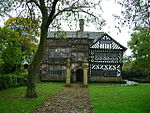
Merseyrail is a commuter rail network which serves Merseyside and adjacent areas of Cheshire and Lancashire. Merseyrail serves 69 stations, 67 of which it manages, across two lines – the Northern Line and the Wirral Line. The network uses 750 V DC third rail electrified lines having 75.0 miles (120.7 km) of routes, of which 6.5 miles (10.5 km) are underground. Since January 2023, Merseyrail commenced replacing its train fleet, withdrawing the Class 507 and 508 trains and introducing 53 new Class 777 trains. The network carried 25.5 million passengers in the 2022/2023 statistical period.

The Liverpool and Bury Railway was formed in 1845 and opened on 28 November 1848. The line ran from Liverpool Exchange first using a joint line with Liverpool, Ormskirk and Preston Railway before branching off to proceed via Kirkby then Wigan and Bolton to Bury.
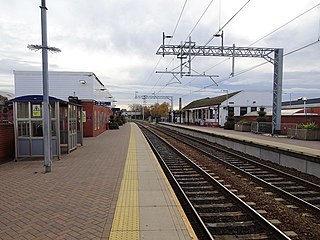
Chorley railway station serves the town of Chorley in Lancashire, England. Since 2004 it has been linked with Chorley Interchange bus and coach station. It is on the Manchester–Preston line.

Wigan North Western railway station is one of two railway stations serving the town centre of Wigan, Greater Manchester, England.

Wigan Wallgate railway station is one of two railway stations serving the town centre of Wigan in Greater Manchester, England. The station serves two routes, the Manchester-Southport Line and the Manchester-Kirkby Line. It is 16 miles north-west of Manchester Victoria. The station is managed by Northern Trains, who operate all trains serving it.

Blackrod railway station serves the towns of Blackrod and Horwich, Greater Manchester, England. It is 6.5 miles north west of Bolton railway station. It is just 1+1⁄4 miles (2.0 km) from the town centre of Horwich - closer than Horwich Parkway station.

Horwich Parkway is a railway station serving the town of Horwich and suburb of Middlebrook in Greater Manchester, England. The station is 16+1⁄4 miles (26.2 km) north west of Manchester Piccadilly on the Manchester to Preston line. The station is close to Junction 6 of the M61 motorway which adds to its convenience as a park and ride railway station. It has digital information displays.

Bolton Interchange is a transport interchange combining Bolton railway station and Bolton Bus Station in the town of Bolton in Greater Manchester, England. The station is located on the Manchester to Preston line and the Ribble Valley line, and is managed by Northern Trains. The station is 11+1⁄4 miles (18.1 km) north west of Manchester Piccadilly. Ticket gates have been in operation at the station since 2016.

Moses Gate railway station serves the Moses Gate suburb of Farnworth in the Metropolitan Borough of Bolton, Greater Manchester, North West England.

Kearsley railway station serves the town of Kearsley and the outlying villages of Stoneclough, Prestolee and Ringley in Greater Manchester, England. It was originally named Stoneclough.

Clifton railway station is a railway station in Clifton, Greater Manchester, England which was formerly called Clifton Junction. It lies on the Manchester–Preston line.

Salford Crescent railway station is a railway station in Salford, Greater Manchester, England, opened by British Rail in 1987.

The Manchester–Preston line runs from the city of Manchester to Preston, Lancashire, England. It is largely used by commuters entering Manchester from surrounding suburbs and cities, but is also one of the main railway lines in the North West and is utilised by TransPennine Express regional services and to Scotland. It was announced in December 2009 that the line would be electrified, following an announcement in July 2009 that the Chat Moss line between Manchester and Liverpool was to be electrified first. The electrification work for this line commenced in May 2015 and was due for completion in May 2018, but was delayed until December 2018.
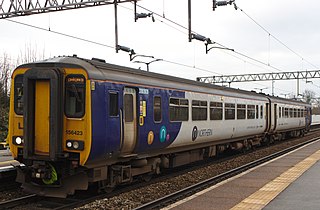
There once were four direct railway routes between Liverpool and Manchester in the North West of England; only two remain, the two centre routes of the four. The most northerly and the most southerly of the four routes are no longer direct lines. Of the remaining two direct routes, the northern route of the two is fully electric, while the now southern route is a diesel-only line. The most northerly of the four has been split into two routes: the western section operated by Merseyrail electric trains and the eastern section by diesel trains, requiring passengers to change trains between the two cities. The fourth route, the most southerly of the four, has been largely abandoned east of Warrington; the remaining section caters mainly for freight trains.
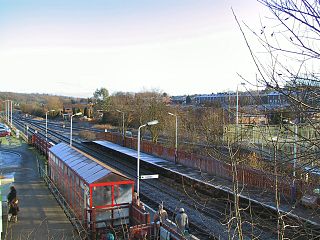
Lostock railway station serves the suburbs of Heaton and Lostock in Bolton, Greater Manchester, England. Built for the Liverpool and Bury Railway in 1852, the station was closed in 1966, then reopened on a smaller scale in 1988 to serve commuters.

The Liverpool–Wigan line is a railway line in the north-west of England, running between Liverpool Lime Street and Wigan North Western via St Helens Central station. The line is a part of the electrified Merseyrail Liverpool to Wigan City Line. The stations, and all trains serving it, are operated by Northern Trains, however the stations are branded Merseyrail using Merseyrail ticketing.

Hindley railway station is a railway station that serves the town of Hindley in Greater Manchester, England. It is on the Manchester to Southport line, west of where the route branches to use either the Atherton line or the Eastern Branch line via Westhoughton, Lostock and Bolton.

Westhoughton railway station is one of the two stations which serve the town of Westhoughton, in the Metropolitan Borough of Bolton, Greater Manchester, north-western England. The station is 15+1⁄2 miles (24.9 km) north west of Manchester Piccadilly.
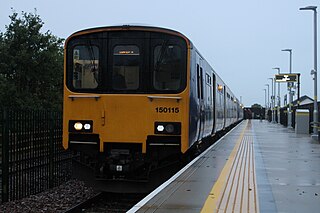
The Kirkby Branch Line is a branch railway line from Wigan to Headbolt Lane. The line's original route was from Liverpool to Bury and later the most northern of the Liverpool to Manchester lines. The line was split at Kirkby in 1977 with the western section forming a high frequency branch of the electrified Merseyrail Northern Line, also referred to as the Kirkby branch line. The Kirkby branch to Wigan remained a low frequency diesel operated service by Northern Trains from Headbolt Lane to Manchester.
North West England electrification schemes are a series of individual railway lines in North West England that have been, and continue to be electrified and upgraded. It is planned that these schemes will result in a modernised, cleaner, lower carbon and faster railway with improved capacity.






















